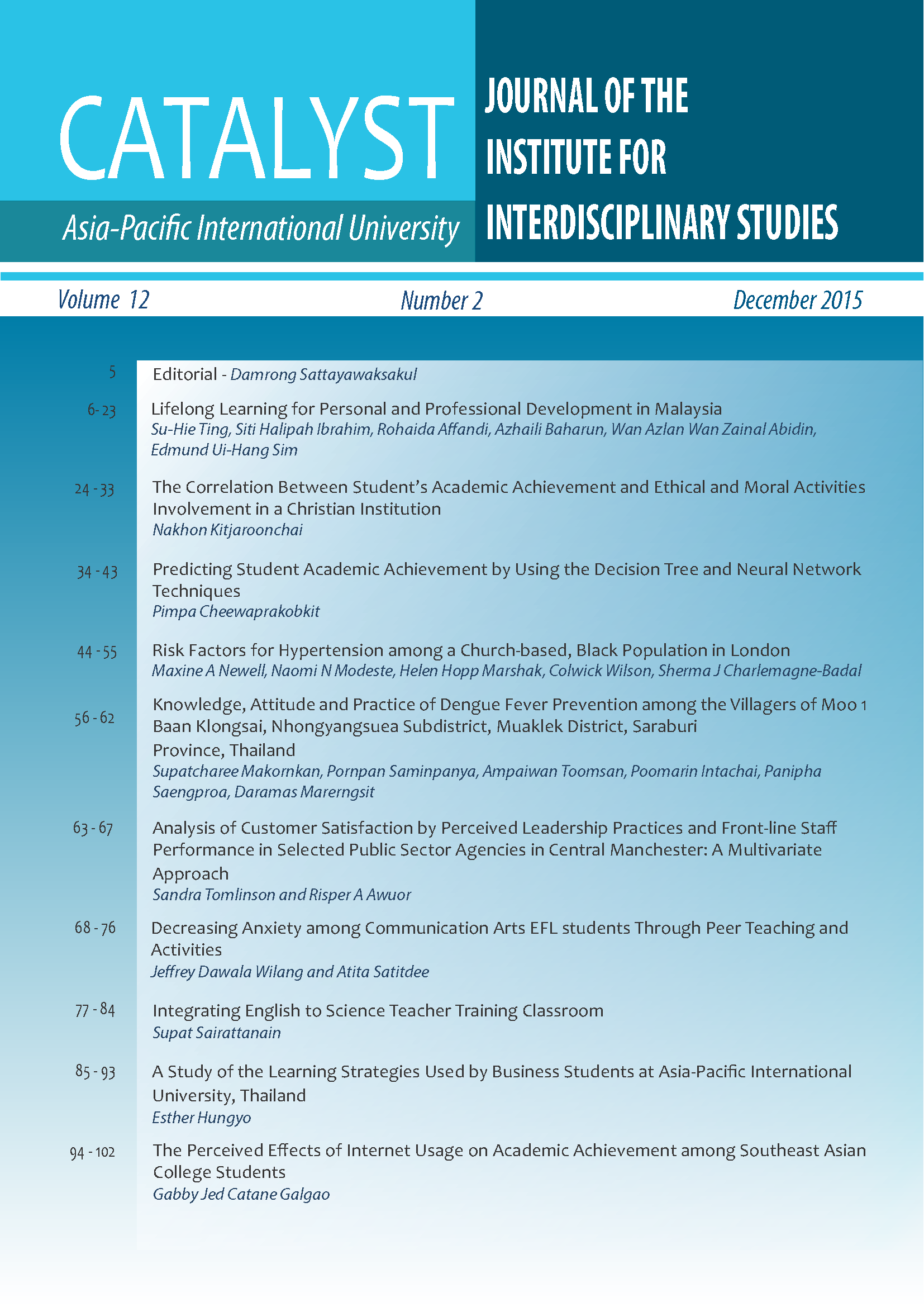A Study of the Language Learning Strategies Used by Business Students at Asia-Pacific International University, Thailand
Main Article Content
Abstract
The aim of this paper is to identify the use of learning strategies by freshman Thai Business students in their study of English at Asia-Pacific International University, Thailand. The two specific objectives were to determine whether Thai students used learning strategies in their language learning and to determine whether successful language learners use more strategies than less successful learners. The sample of the study involved 26 Thai Business students. The sample completed the Strategy Inventory for Language Learning (SILL), which consisted of thirty-three questions divided into six sub-strategies. The results obtained indicate that (a) the majority of the students were conscious of their use of strategies, (b) meta-cognitive strategies were commonly used, (c) strategies were used extensively by more successful language learners, and (d) appropriate use of strategies facilitated learners’ learning language.
Article Details

This work is licensed under a Creative Commons Attribution-NonCommercial-NoDerivatives 4.0 International License.
Copyright: Asia-Pacific International University reserve exclusive rights to publish, reproduce and distribute the manuscript and all contents therein.
References
Chamot, A. U. (2004). Issues in language learning strategy research and teaching. Electronic Journal of Foreign Language Teaching, Vol. 1 (1), p. 14-26. Retrieved March 30, 2010, from http://e-flt.nus.edu.sg/ v1n12004/chamot.pdf
Cheng, X. (2000). Asian students’ reticence revisited. System, 28(3), 435-446.
Cohen, A.D. (1998). Strategies in learning and using a second language. TSEL-EJ Teaching Language as a Second or a Foreign language. Vol.3 (4). January 1999. Retrieved November 30, 2010, from http:// www.tesl-ej.org/ej12/r10.html
de Segovia, L. P., & Hardison, D. M. (2009). Implementing education reform: EFL teachers’ perspectives. ELT journal, 63(2), 154-162.
Foley, J. A. (2005). English in… Thailand. RELC journal, 36(2), 223-234.
Gan, Z. (2009). ‘Asian learners’ re-examined: an empirical study of language learning attitudes, strategies and motivation among mainland Chinese and Hong Kong students. Journal of Multilingual and Multicultural Development, 30(1), 41-58.
Hong-Nam, K., & Leavell, A. G. (2006). Language learning strategy use of ESL students in an intensive English learning context. System, 34(3), 399-415.
Kember, D. (2000). Misconceptions about the learning approaches, motivation and study practices of Asian students. Higher Education, 40(1), 99-121.
Nisbet, D. L., Tindall, E. R., & Arroyo, A. A. (2005). Language learning strategies and English proficiency of Chinese university students. Foreign Language Annals, 38(1), 100-107.
Oxford, R. L. (1986). Development and psychometric testing of the strategy inventory for language learning (SILL). ARI Technical Report 728. Alexandria, VA: Army Research Institute.
Oxford, R. L., & Burry-Stock, J. A. (1995). Assessing the use of language learning strategies worldwide with the ESL/EFL version of the Strategy Inventory for Language Learning (SILL). System, 23(1), 1-23.
Park, C. C. (2000). Learning style preferences of Southeast Asian students. Urban Education, 35(3), 245-268.
Park, G. P. (1997). Language learning strategies and English proficiency in Korean university students. Foreign language annals, 30(2), 211-221.
Purdie, N., Hattie, J., & Douglas, G. (1996). Student conceptions of learning and their use of self-regulated learning strategies: A cross-cultural comparison. Journal of Educational Psychology, 88(1), 87.
Ramburuth, P., & McCormick, J. (2001). Learning diversity in higher education: A comparative study of Asian international and Australian students. Higher education, 42(3), 333-350.
Wharton, G. (2000). Language learning strategy use of bilingual foreign language learners in Singapore. Language learning, 50(2), 203-243.
Wong, J. K. K. (2004). Are the Learning Styles of Asian International Students Culturally or Contextually Based?. International Education Journal, 4(4), 154-166.


